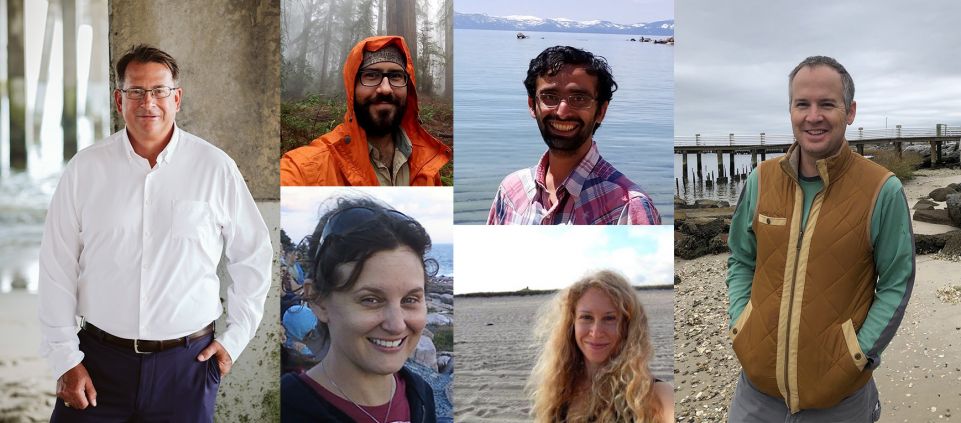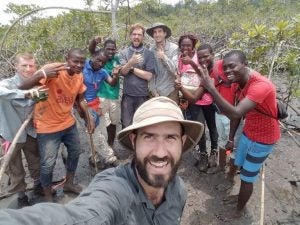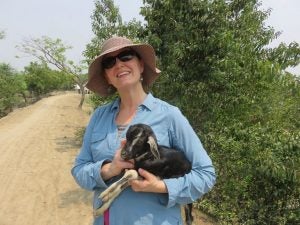ECU and CSI See Significant Growth with New Faculty Hires
The Department of Coastal Studies (DCS) in East Carolina University’s new Integrated Coastal Programs (ICP) unit and the Coastal Studies Institute (CSI) are proud to welcome a new cohort of interdisciplinary coastal scientists to join ECU at the Outer Banks Campus this academic year. David Lagomasino (landscape geomorphology, ecohydrology, and remote sensing) and Kimberly Rogers (coupled human-natural systems and coastal processes) are first to arrive in August 2019 and will be joined by Nadine Heck (human-environment geographer), and Siddharth Narayan (coastal engineer) in January 2020. These four faculty, hired as a tenure-track interdisciplinary cluster, are part of a major ECU investment in research and teaching programs focused on ocean margins and research relevant to coastal North Carolina. Coming from throughout the U.S. and with research experience around the world, each new faculty specializes in relevant and pressing aspects of coastal change, including perceptions of change; the influence of policy-driven decisions on sustainability; event-driven physical changes; and community response to the impact of changing climate patterns. They, along with the motivated faculty already in the department, will also participate heavily in the department’s newly redesigned coastal PhD program and development of place-based courses to create and broaden opportunities for ECU students to learn and live at the coast.

New coastal faculty at ECU and CSI include (from left to right) George Bonner, David Lagomasino (top), Kimberly G. Rogers, (bottom), Siddharth Narayan (top), Nadine Heck (bottom) and Jim Morely.

David Lagomasino
David Lagomasino is a remote sensing scientist coming from the University of Maryland. He holds a PhD in geosciences from Florida International University and is the longest running pirate of the bunch, having earned his Master of Science degree in geology right here at ECU. David’s work utilizes airborne platforms such as drones, planes, and satellites outfitted with a range of sensors (thermal infrared, hyperspectral etc.), to measure a variety of characteristics: land cover, structural details, height, elevation, and spatial as well as thermal properties. “The captured imagery illustrates on a large scale how fast the world is changing, particularly along the highly dynamic coastline,” says David. “It puts things in perspective by presenting evidence of the interaction between natural systems and human and urban systems.”
Lagomasino’s work first drew him to the Albemarle Pamlico Estuarine System during his early graduate studies at ECU conducting research on marsh sedimentation in the Pamlico Sound. Since, his work has brought him around the world to geospatially analyze mangrove forests, land use, and natural disaster recovery. In the Department of Coastal Studies, David intends to work along the Pamlico and Albemarle sounds analyzing the shorelines by applying his remote sensing tool kit and knowledge of coastal ecosystems. Specifically, he is looking forward to collaborating across disciplines with DCS colleagues to determine where things are changing and to identify vulnerable areas in fishery and human communities.

Kimberly G. Rogers
Kimberly Rogers earned her doctorate in Environmental Engineering at Vanderbilt University and joins the ECU Department of Coastal Studies from the University of Colorado Boulder. Her research integrates quantitative and qualitative approaches, such as field measurements of sedimentation, computational models, and ethnographic techniques, to explore complex feedback between fluvial and coastal processes, global change, and human decisions regarding land use and infrastructure that are shaping deltas and their coastal environments. Like Lagomasino, Kimberly’s work has taken her to shores all over the world. Some of her recent work took place in the Ganges river delta in Bangladesh, the largest and most populated river delta in the world, to examine sediment transport and how human activity affects surrounding natural resources. By combining methodologies from both natural and social sciences, Kimberly’s work is an excellent example of interdisciplinary coastal science.
“I am thrilled to be joining the ECU ICP and CSI families this fall and to bringing my interdisciplinary perspective on coastal processes to the Outer Banks.” Says Rogers. “The Outer Banks provide a superb natural laboratory for studying the two-way influence that the natural environment and society have on each other. While my research has mainly focused on the processes influencing resilience of coastal mangroves and floodplains within the world’s populated river deltas, I am eager to explore how the same principles apply to the diverse settings of North Carolina’s outer and inner banks. Above all, I am eager to contribute to CSI’s growth; I am looking forward to joining CSI’s faculty, staff, and students in building the Integrated Coastal Programs into an extraordinary educational and scientific resource for the greater OBX community and beyond.”
In addition to expansion in the Department of Coastal Studies, the Coastal Studies Institute and ECU Outer Banks Campus are experiencing growth across other departments, including the addition of Jim Morley, Coastal Ecologist, ECU Department of Biology; and George Bonner, NCSU Department of Civil, Construction and Environmental Engineering and Director of the NC Renewable Ocean Energy Program. These six new faculty hires will be located at the Outer Banks Campus full time, increasing ECU’s research and curriculum capabilities at the coast.